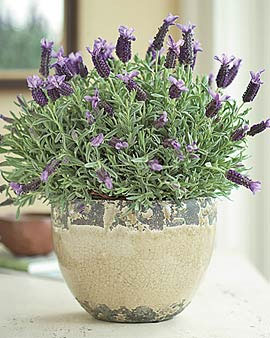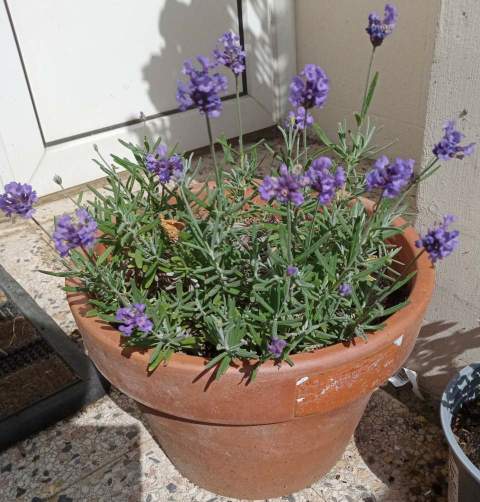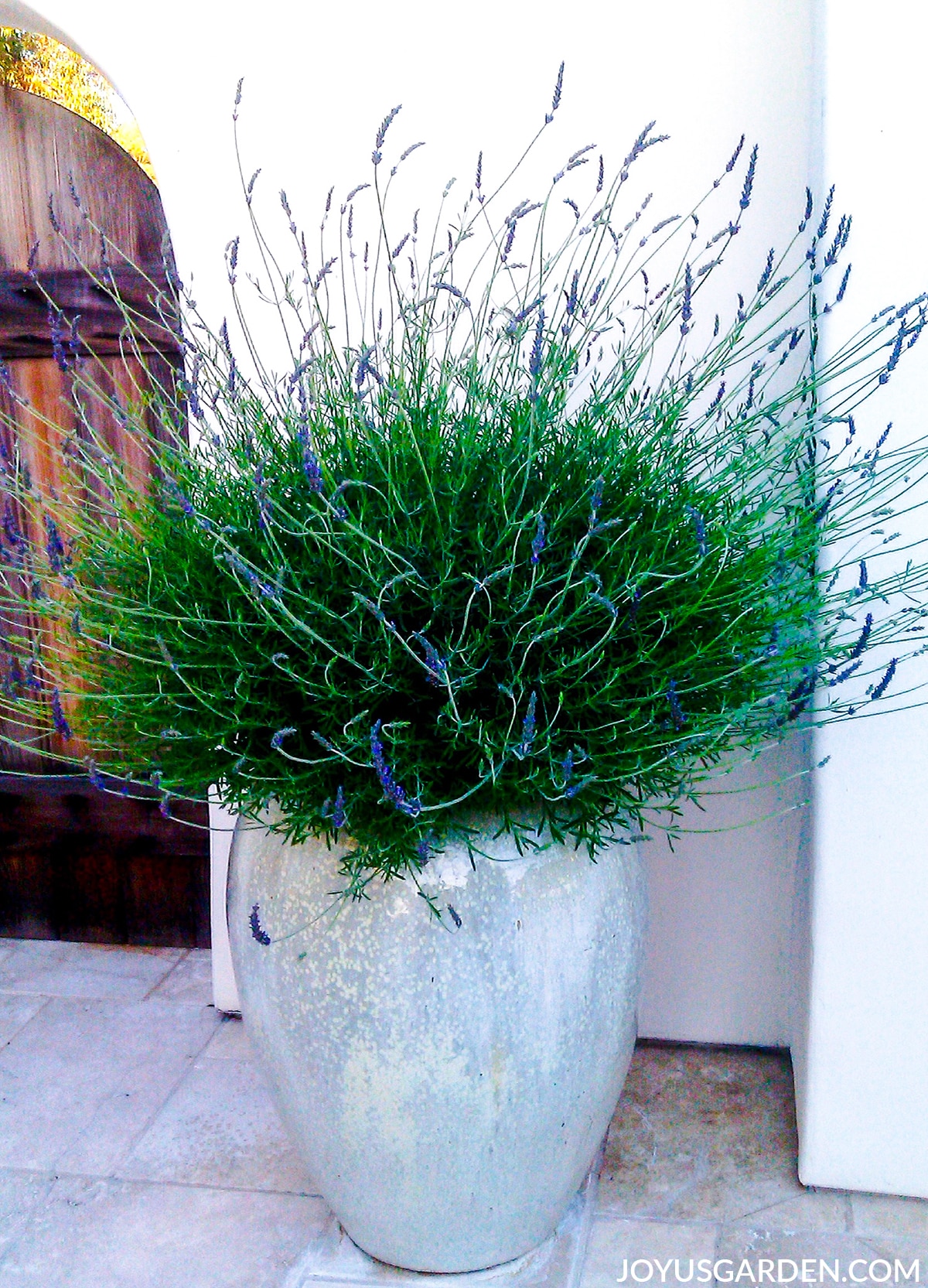If you mimic the conditions of their natural environment, French lavender grows remarkably well in pots and requires only moderate maintenance. An overview of how to care for potted French lavender is provided below:
| French lavender in a pot | Care Guidelines |
| pot filler: | Sand has been added to 2/3 of multipurpose potting mix to improve drainage. |
| Watering: | After planting, water liberally for the first three months with regular application. In hot and dry weather, only drink water every two to three weeks. French lavender flourishes in hot, dry weather. |
| Sun: | Stronger blooms are encouraged by full sun. |
| Fertilizer: | Avoid using fertilizer. French lavender prefers soil with low to moderate fertility. In contrast to flowering, fertilizer promotes the growth of leaves. |
| Containers and Pots: | With multiple drainage holes on the pot’s base, it measures 12 to 16 inches across. Pots made of clay, terracotta, or ceramic are favored. |
| Winter Care | Since French lavender is not cold-hardy and won’t withstand frost, bring it indoors for the winter. If indoors in the winter, water once every four to six weeks. |
| Pruning: | Once a year, prune either at the beginning of the spring or after the fall blossoming. |
| Flowering Period | Starting in the Spring (May/June), French lavender blooms for up to three months until the Fall. Full sun encourages French lavender to blossom for longer. |
| favored varieties | “Anouk,” “Regal Splendor,” and “Ballerina” |
For further advice on how to take care of potted French lavender, keep reading…
Table of Contents
Potting Mix for French Lavenders Soil
In order to mimic their natural growing circumstances, French lavenders demand quick-draining, sandy soil that is generally low in fertility and has a slightly alkaline soil pH.
Therefore, these soil qualities should be included in the potting mix.
The garden center’s general or multipurpose potting compost is ideal for French lavenders. However, it’s crucial to add horticultural sand, also known as sharp sand or builders sand, or perlite to about one-third (by volume) of the pot.
The quick-draining, porous structure that lavenders need is provided by sufficient quantities of sand or perlite. Additionally, because these components do not provide many nutrients to the soil, the fertility of the potting soil is balanced and relatively low, which French lavender appreciates.
The necessity of adding sand to the potting mix is highlighted by the fact that lavender plants grown in rich soils or with additional fertilizer will show signs of stress, such as turning yellow and having a weaker aroma, due to an excess of nitrogen in the soil.
French lavender can handle soil with a pH of 6.5 (slightly acidic), but prefers neutral and alkaline soils, thus avoid using ericaceous (acidic) compost (7-8).
French lavenders need an alkaline pH, so add a tablespoon of agricultural lime to the soil to make it more so, or add half a cup of wood ash to assure this.
Avoid making these errors!
French lavender will grow poorly in pots with soil that has moisture-retentive granules because the roots will retain too much moisture.
Watering
French lavenders can withstand the intense summer weather. They can survive in hot, dry situations that would seem harsh to other plants since they are not only heat- and drought-resistant but also flourish in them. (Difficult in USDA zones 7–11)
Once they are established in the container, French lavenders frequently do not need any extra watering; in a few specific situations, which I have listed in the table, watering may be necessary.
Lavenders are indigenous to Southern Europe’s arid Mediterranean region, where plants grow well in quick-draining soils with little water. To ensure a healthy plant with a potent aroma, gardeners must emulate the circumstances of their original settings by watering sparingly.
overwatering French ivy in pots Due to its susceptibility to root rot if the roots are left in continuously moist soil, lavender causes considerably more issues than just underwatering.
| Conditions for French Lavender | Watering French lavender in a pot |
| Following planting | French lavender is only susceptible to drought when it has just been planted since the roots have not yet fully taken hold. For the first week and the first three months, water liberally once every three days. For the first year, reduce watering to once every two weeks. |
| In the Summer | Once established, French lavender frequently doesn’t need any watering if grown outdoors and gets all the moisture it needs from rain. Water once every two or three weeks with a deep soak in persistently hot, dry weather without rain. |
| Strong Rainfall | Your potted French lavender doesn’t need watering if there has been generally constant rainfall during the growing season (Spring or Summer months). Lavenders won’t grow in soil that is overly wet from further irrigation. Sand should be added to the potting mix in high rainfall regions to improve drainage. |
| In the Winter | Lavender plants require no watering from late Fall to early spring if they are kept outside because they are in a dormant state during the winter. Water the lavender plant once every 4-6 weeks if you bring it inside during the winter to avoid freezing temperatures. |
| watering too much | By adding coarse sand to the potting mix to increase drainage, you may prevent overwatering lavender. Additionally, pots offer better drainage than garden borders. You won’t have any issues related to overwatering if you don’t water more frequently than every two to three weeks. |
Place in Full sun
One of the most drought- and heat-resistant varieties of lavender, French lavender prefers direct sunlight (ideally more then 6 hours of sun per day).
The possibility for a large number of blossoms and a rich perfume increases with the amount of sunlight.
French lavender won’t thrive in partial shade, and you’ll get leaner growth and fewer flowers.
The hot, dry weather will be maintained by the full sun, mimicking the region where lavender originally came from in Southern Europe. Plants that receive direct sunlight thrive and are much less prone to illness.
Avoid using Fertilizer
- The potency of the smell
- disease resistance
- Amount of Blooms
If the soil is fertilized, the lavender plant will grow leggy, frequently with yellow leaves, and produce significantly fewer flowers. French lavender is specifically adapted to grow in sandy soil with few nutrients, which is in contrast to the conditions where they grow and thrive in their native area. Fertile soils are not ideal for French lavender.
In order to ensure that your French lavender grows properly, add sand to the potting mix. French lavender are minimal maintenance plants that thrive and yield the greatest flowers in relatively nutrient-poor soil.
Choosing the Right Pot
Pick a container with drainage holes in the base because lavender plants detest soggy soil. The diameter of the container should be between 12 and 16 inches. This size pot makes sure there is adequate room for soil so that the roots can properly establish and reach the moisture and nutrients they need.
The roots won’t take hold as effectively in a small pot, and the growth of the lavender plant may become stunted.
The best pots are typically made of clay, terracotta, or ceramic since they are thicker than plastic and metal ones and do not heat up as much in the sun, keeping the roots cool and preventing the soil from scorching in the hot sun.
Just be careful not to set the lavender plant’s pot on a drip tray because this will collect all the water and keep the soil damp, which encourages the growth of fungi that can cause root rot, which can cause the lavender to die.
Read my post, Choosing the Best Pot for Lavenders, for illustrations of appropriate containers.
French Potted Lavender Care in Winter
French lavender is a relatively delicate plant that has to be protected from frost during the winter. You must bring the pot indoors over the winter if you live in a region with freezing temperatures since the lavender won’t survive outside.
Only moderate climes, such those in California or Southern Europe, are suitable for leaving French lavender outdoors.
French lavender in a container has the benefit of being simple to move indoors before the first winter frost.
Move the potted lavender into a heated greenhouse, a garage, or a bright window indoors when nighttime lows are around 5°C (41°F).
The lavender will still benefit from as much sunlight as it can get even though it is dormant during the winter. Bringing lavender indoors will add fragrance to your home because it emits its delicious aroma from its foliage all year long (although it is strongest in spring).
If the plant is indoors during the winter, water the lavender sparingly just once every four to six weeks to prevent the pot from drying out totally for extended periods of time.
When you are certain there won’t be any more frosts, put the lavender back outside in the spring in a lovely bright spot.
Read my article on winter care for French lavenders for further details and recommended practices.
Prune in the Spring for more Flowers
Pruning French lavender in a container is the same as pruning lavenders grown in other environments.
When to prune lavender is a subject of debate between two groups of people. Cut back the plant:
- Just as the plant’s new growth starts to appear from its base at the beginning of spring, or…
- After flowering in the fall, prune.
Both methods are effective, but I’ve personally noticed that lavender is pruned more successfully in the spring. This is because the stems that will support the season’s flowers are supported by the new growth, and spring pruning is more efficient at promoting these stems.
As a result, I have observed more blossoming on lavender that was pruned in the spring as opposed to lavender that was pruned in the fall.
As pruning would slow down the creation of wood from the plant’s base, it is crucial to prune lavender every year to increase its lifespan.
Trim only the top third of the plant’s soft, pliable growth; avoid cutting the woody root of the plant because decayed wood does not regenerate. To resist the effects of weather damage and to promote the most flowers, always aim for a mound form.
For a visual explanation, check out the following YouTube video:
French Lavender Indoors
———————————-Just be careful not to set the lavender plant’s container on a drip tray as this will collect all the water and keep the soil damp, which fosters the growth of fungi that can cause root rot, which can be fatal to lavender.
Read my post, Choosing the Best Pot for Lavenders, for examples of acceptable containers.
In the winter, French lavender needs to be protected from frost because it is a relatively delicate plant. The lavender won’t survive the winter if the pot is left outside in a climate with freezing temperatures, so you must bring it inside.
Key Takeaways:
- Only mild conditions, such those in Southern Europe or California, are suitable for leaving French lavender outdoors.
- It is simple to move potted french lavender indoors before the first winter frost, which is an advantage.
- Move the potted lavender into a heated greenhouse, a garage, or a bright window indoors after nighttime lows are at around 5°C (41°F).
- Despite going dormant over the winter, lavender will still benefit from as much sunlight as possible. Even while the lavender’s pleasant aroma is strongest in the spring, it emits it from its foliage all year long, so bringing it inside will give your home an additional smell.
- If the plant stays indoors throughout the Winter, water the lavender sparingly just once every four to six weeks to prevent the pot from drying out totally for extended periods of time.
- In the spring, when you are certain that there won’t be any more frosts, put the lavender back outside in a lovely, bright spot.
- Read my article on winter French lavender maintenance for more details and recommended procedures.
FAQ
How do you keep French lavender blooming?
French lavender in a pot can be pruned in the same way as lavender in other environments.
How long does French lavender flower for?
When to prune lavender, there are two distinct schools of thinking. Trim the plant, if necessary:
How long does French lavender last in the garden?
A few days before the plant’s base starts to sprout new growth in the spring, or…
When should I cut back French lavender?
Following flowering, prune in the fall.
How do you make French lavender bloom?
Both are effective, but I’ve found that pruning lavender in the spring yields the best outcomes for me. This is so because the stems on which the flowers of the season will grow are stimulated by the new growth, which is why pruning in the spring is more effective at doing this.



